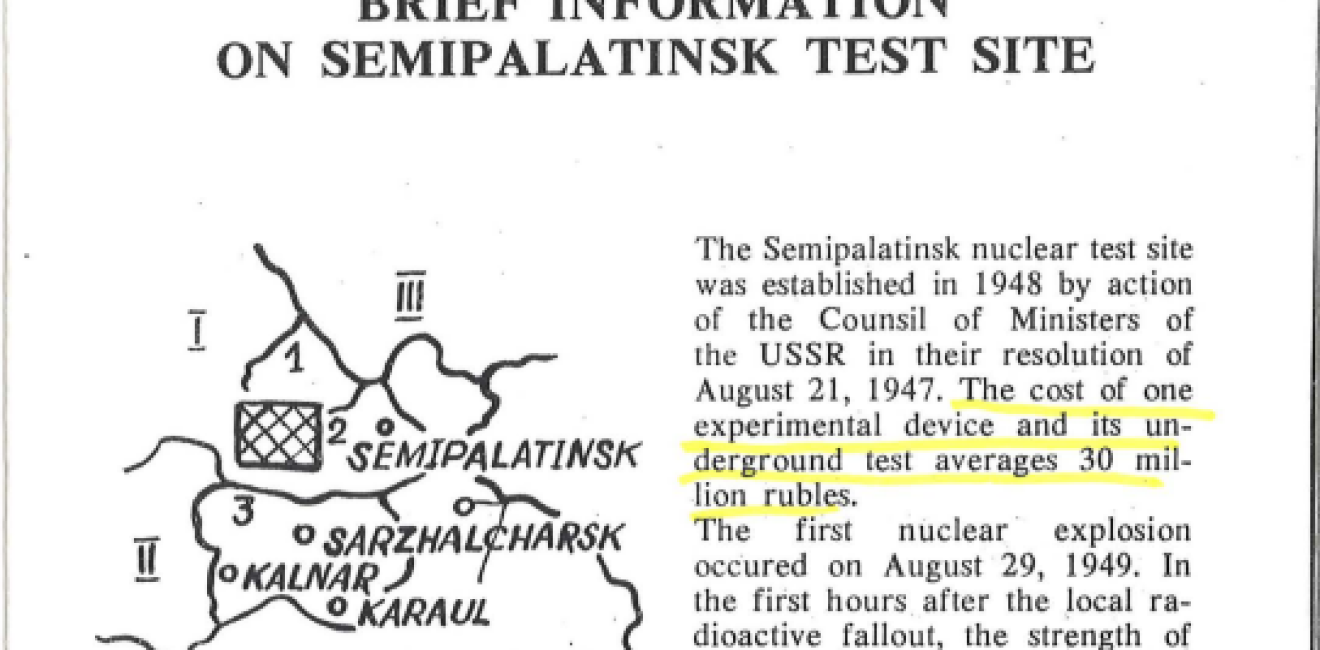When the Semipalatinsk Nuclear Test Site permanently closed on August 29th, 1991, Kazakhstan’s (then) President, Nursultan Nazarbayev, mentioned the Nevada-Semipalatinsk movement by name. Nazarbayev characterized the Nevada-Semipalatinsk as a movement “which brought together scientists, writers, employees, workers, and many people of all ages, [and] made a huge contribution to the struggle to close the Semipalatinsk nuclear test site and suspend the activities of other test sites in the world.”
Indeed, the Nevada-Semipalatinsk Movement, a grassroots anti-nuclear group founded in 1989 and based out of Kazakhstan, was a major player in the fight against nuclear testing and proliferation at the end of the 20th century. After helping to close the Semipalatinsk Nuclear Test Site, the group remained active with a pointed focus on international non-proliferation, recognizing that “Kazakhs alone cannot close all the test sites in the world.”
A new collection of primary source documents, donated to the Wilson Center by Professor Matthew Evangelista and partially available via DigitalArchive.org, is a rich source of material regarding the Nevada-Semipalatinsk Movement’s activities.
The papers donated by Professor Evangelista to the Wilson Center consist of seven folders with the following titles:
- Alma Ata Congress
- International Citizens Congress for a Nuclear Test Ban, Alma Ata '90
- IPPNW
- Nevada Movement
- Nevada-Semipalatinsk
- Semipalatinsk
- Sov-N Tests 1990
In the remainder of this article, I provide an overview of the types of documents found in the collection and their significance.
Newspapers, Newsletters, and Print Media
The collection includes a diverse range of newspaper articles and newsletters about the Nevada-Semipalatinsk Movement. The majority of the newsletters were produced by anti-nuclear activist groups that were active alongside Nevada-Semipalatinsk, including International Physicians for the Prevention of Nuclear War (IPPNW), the United States Comprehensive Test Ban Coalition, and the International Society for Human Rights (ISHR).
The Nevada-Semipalatinsk Movement’s extensive international network are reflected in the calls to action found in many of the newsletters. For example, the July-August 1990 issue of The New People July, a publication of the Thomas Merton Center, highlighted that Peace Links, a network of women against nuclear war, joined the Nevada-Semipalatinsk Movement to protest against nuclear testing in Kazakhstan. Many of the newsletters recount the experience of individuals from groups like International Physicians for the Prevention of Nuclear War (IPPNW), Bay Area Peace Test, and The Western States Legal Foundation's participating with Nevada-Semipalatinsk.
Outside of newsletters produced by anti-nuclear groups, the Nevada-Semipalatinsk Movement received coverage from a range of news outlets spanning from Moscow to Las Vegas. In a 1990 June issue of The European, a reporter and photographer covered the crisis in the Semipalatinsk region in a feature-length article. The article details the secrecy surrounding the testing site, sloppy protocol and rampant accidents, and the effects that repeated fallout and radiation exposure had on the local population. Newspapers from cities across the United States, including Las Vegas, St. George, Oakland, Pittsburgh, and others also reported on the Nevada-Semipalatinsk Movement. Throughout this coverage, Nevada-Semipalatinsk and Kazakh citizens writ large were painted in an exemplary light, and were hailed for their success at frustrating Soviet testing. It is surprising that the movement was covered with such depth and nuance, as anti-nuclear activists were often not afforded positive framing in the Western media.
The collection’s newsletters additionally offer researchers primary source information on the experiences of activists who attended the International Citizen’s Congress for a Nuclear Test Ban in Alma-Ata in May 1990, and what kinds of issues local activists focused on. These include passing a comprehensive ban on nuclear testing and reducing the world’s nuclear arsenal. The newspaper articles offer researchers a wealth of information on how the Nevada-Semipalatinsk Movement reacted to activism both in the United States and the USSR. Moreover, they provide insight into the role public perception played in shaping opinions on nuclear programs at home and abroad.
Programs from the International Citizen Congress for a Nuclear Test Ban
The International Citizen’s Congress for a Nuclear Test Ban, which was co-hosted by the Nevada-Semipalatinsk Movement and the IPPNW, brought together hundreds of activists, lawyers, scientists, and survivors from different nations to the then capital of Kazakhstan, Alma Ata, to advocate for a comprehensive ban on nuclear testing.
The International Citizens Congress part of the collection includes programs and itineraries in English, Russian, and Kazakh that describe the events of the Congress. These documents help put the experience of the attendees, like the ones described in the newspapers mentioned above, into context. Additionally, they give researchers insight into the planning and logistics of the event.
Foreign Broadcast Information Service
The Evangelista papers also include a number of items from the Foreign Broadcast Information Service, also known as FBIS. Providing English translation of foreign radio broadcasts, the FBIS documents in this collection are from the Russian and Kazakh Republics of the Soviet Union. The broadcasts provide important insights into the events that led to the closure of the Semipalatinsk site, the political environment surrounding the site’s closure and Soviet debates over limited test ban treaties. These documents offer those without Russian-language proficiency the chance to see how the Soviet Union covered the activities of Nevada-Semipalatinsk. Moreover, the choice in which broadcasts were translated poses interesting questions about what kinds of content the FBIS found relevant.
Russian Language Documents
Many documents in the collection have not yet been translated from their original Russian. These newspapers, personal correspondences, programs, and other materials allow a researcher with Russian language proficiency to explore the Nevada-Semipalatinsk Movement, the International Citizen’s Congress for a Nuclear Test Ban, and the attitudes of Soviet citizens towards nuclear proliferation from the Soviet perspective.
This collection provides a multidimensional view of the Nevada-Semipalatinsk Movement's activities and their efforts to combat nuclear proliferation. The of materials present in this collection represent a variety of viewpoints, and raise interesting questions about the role of activists and the media in nuclear policy. For researchers interested in the history of nuclear disarmament, grassroots activism, and/or the end of the Cold War, this collection will serve as a rich resource.
Researchers interested in these documents should first review the materials published on the Digital Archive. Researchers can also contact the Wilson Center’s History and Public Policy Program to view the entire collection.







